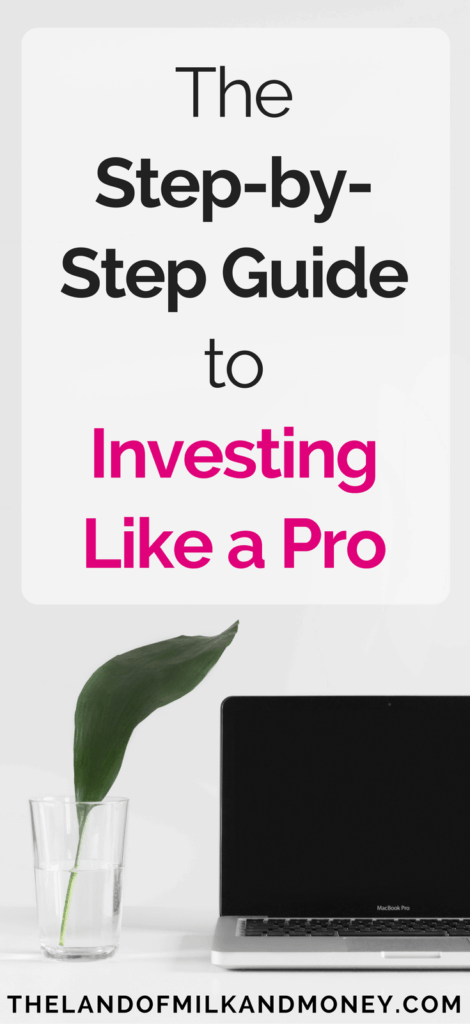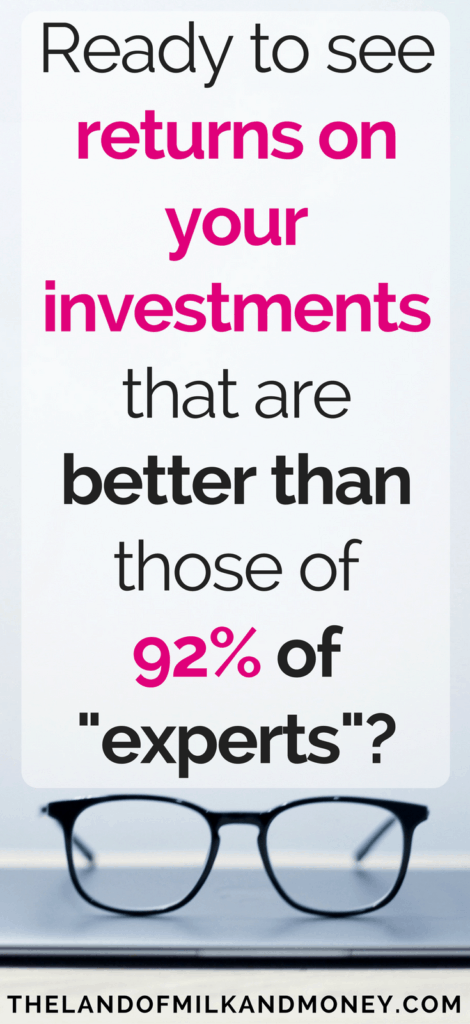Welcome to Step 4 of the Step-by-Step Guide to Investing Like a Pro!
I assume that you’ve read the earlier steps of this Guide, right?
- Step 1: The Beginners’ Guide To Investing Like An Expert (Including How To Beat The Professionals)
- Step 2: How To Invest Your Money For The Best Returns (For The Least Amount Of Cost and Effort)
- Step 3: How To Prepare For Risks To Your Investments – And Turn Them Into Rewards
If not, go and take a look at those first. You’ll need to know exactly why you should be investing in index funds before going further in this article.

That’s because this post will set out exactly how you can invest in an index fund – including recommendations on how to maximise your returns.
How do I invest in an index fund?
Just like an index fund itself, investing in index funds is an extremely easy, quick and cheap process.
There are several different ways you can do this through a number of different companies. However, I’m going to recommend the one that I – and many (if not most) other personal finance bloggers – use: Vanguard.
I should note here that I am not an affiliate for Vanguard. As such, I do not receive any money or other type of compensation for recommending them.
They are simply the company that I believe offers the best way to invest in index funds. I have used them for years and am a very satisfied customer.
What is Vanguard?
Vanguard was established by Jack Bogle in 1974 who, in turn, created the first index fund in 1976.
As mentioned in Step 1 of the Step-by-Step Guide to Investing Like a Pro, in only 40 years after the establishment of the first index fund, just over a third of all assets in the US are in passive funds (source). This is up from 20% of all assets only ten years ago. Vanguard alone holds around $4.5 trillion in global assets at the time of writing.
This is great and all, but it’s not why I choose to invest with Vanguard. Instead, one of the main reasons is because of the structure of the company, which allows it to be extremely low-cost.
Vanguard was established as a cooperative. That is, when you buy into a Vanguard fund, you become a shareholder of Vanguard.
This means that, instead of distributing profits, it uses that money to lower its fees. Accordingly, when Vanguard makes money, you make money.
We’ve already covered in Step 2 why having low fees is of the utmost importance in order to maximise your investment returns over time. So when there’s a company whose entire business model is focussed on ensuring that fees are as low as possible, then they’re certainly worthy of your consideration.
How to invest
Vanguard has over 60 funds that track a range of different markets and sectors.
However, there is only one you need to reap the benefits of index funds: VTSAX.
I’ve discussed some of the benefits of VTSAX in Step 2 of the Step-by-Step Guide to Investing Like a Pro: How To Invest Your Money For The Best Returns (For The Least Amount Of Cost and Effort).
In particular, by buying VTSAX, you are actually buying a piece of every company that is traded on the US stock market. Specifically, you will be getting a piece of (at the time of writing) 3,599 companies.
Clearly this gives you extensive exposure to the US market. However, it also provides you with international exposure given that many companies that are publicly traded in the US have operations overseas as well.
All together, this is an epic amount of diversification.
In addition to this, VTSAX also provides all of the benefits of index funds more generally. In particular, as covered in Step 1 and Step 2 of this Guide:
- It consists solely of stocks. This is great for you as stocks have, historically, provided the best returns over time;
- It is of far lower risk than owning individual stocks. This is because if you choose to invest in this way and a specific stock crashes, you lose all your money. If a specific stock crashes in an index fund that tracks the entire market like VTSAX, that stock simply moves out of the index and is replaced by another one that is performing better. Your money is thus much better protected;
- It has been shown time and time again that investing in an index fund compared to an actively managed fund will result in better returns in more than 92% of cases; and
- The fees for a passively managed index fund are far lower than an actively managed fund, thus allowing you to maximise your returns.
On this last point, VTSAX is particularly impressive, with an expense ratio (i.e. the annual fee) of only 0.04% of your total investments. You would never ever get fees this low for an actively managed fund.
Want a refresher on how important it is for your overall wealth to have low fees? Take a look at Step 1 of this Guide: The Beginners’ Guide To Investing Like An Expert (Including How To Beat The Professionals).
There, you will see an example where Homer and Marge both decided to start investing. Marge, as a wise reader of The Land of Milk and Money, invested in an index fund that had, oh wait, an expense ratio of 0.04%. How coincidental!
The difference in fees resulted in Marge being $80,000 better off – and that’s with Homer investing in an actively managed fund that had relatively low fees for that investment class. Imagine how much worse off he’d be if those fees were north of 2%, as they often are!
Remember: you can’t control your returns but you can control your fees. And 0.04% is about as low as you can get.
Is it really this simple?
It certainly can be!
Index funds are almost as simple as they come. But, as mentioned in Step 1, I don’t choose to invest in index funds because they’re simple – although it’s a nice bonus!
Instead, index funds are the best investment strategy because they consistently have the best returns over time.
Personally, I keep all of my investments in one Vanguard index fund. In the interests of disclosure, it’s not VTSAX, but this is only because I don’t live in the US and thus don’t have access to it.
The fund that I use is the overseas equivalent of VTSAX. It’s exactly the same idea from the same company with a different name.
However, as the vast majority of the readers of The Land of Milk and Money are from the US, I have chosen to write this article from the perspective of someone who has access to Vanguard’s US funds. And for all of you, VTSAX is, in my opinion, absolutely the best option.
(For those of you who live in other countries where Vanguard has offices, check their local website for the international equivalent.)
Should you put all of your money into one index fund?
I do!
However, I fully acknowledge that this is a fairly aggressive investment strategy that isn’t for everyone.
Putting all of your money into stocks, including through an index fund, can, as mentioned in Step 3, result in a fairly rocky ride at times.
While the market always goes up, the inevitable short term dips can test the nerves of even the steeliest of investors.
As such, the decision on how to arrange your investment portfolio depends largely on your risk appetite.
What is your risk appetite?
This article sets out several considerations that together consist of your risk appetite.
These include:
- Your personal attitude to risk;
- Your investment goals, time frame and need for returns; and
- Your personal circumstances i.e. how much you can afford to lose.
In my case, I’m in my early 30s so, I’ll probably (hopefully?) live for about another 60 years. This means that I have the time to ride out any market crashes that may happen in the short term.
Age should not, however, be the sole factor in determining your risk appetite. After all, with today’s life expectancies, even someone who is more than double my age has enough time to see the market recover after a crash.
So let’s consider some other factors.
In my case, I plan to retire well before I turn 40. As such, I’m at a stage in my life where I’m looking to build my wealth as quickly as possible so as to have enough money to reach financial freedom. I don’t, however, want to take any risks that are too extreme (no bitcoins for me!). This is just in case this strategy backfires and results in me having to delay my planned early retirement.
I work full-time and am fortunate in that I don’t have any real concerns that this will change in the near future. This means that, at present, I have a steady income stream that I can rely upon if the market drops at any point.
I’m also looking to maintain my investments for the rest of my life. After all, I believe in the 4% rule to sustain my lifestyle after I retire. I therefore need a very long term investment strategy. In my case, this involves investing in an index fund that tracks the market. I made this choice in light of the fact that history has shown that any drops in the short-term are eventually corrected.
I don’t have a mortgage (I rent), debt or any other significant financial commitment. I also have a few months of living expenses built up, just in case I need to dip into them in the event of an emergency.
Based on the above, I’ve decided that I can stomach the short-term risks involved in investing 100% in VTSAX. This is to allow my portfolio to benefit from the long-term advantages that this entails.
Will this work for you?
Your situation is likely to be different from mine. As such, think carefully about the various aspects of your life that may affect how much risk you are willing to take on.
You may want to build your wealth as aggressively as possible. Alternatively, you may be at a stage where you’re more interested in maintaining the wealth that you have.
You may be in your 20s with your entire working life ahead of you in order to make money. On the other hand, you may be in your 70s and would prefer to live solely off what you have already accumulated.
You may be concerned about whether you’ll still have your job in three months. You may, however, be about to re-enter the workforce after having spent the last few years studying with no income.
You may have no mortgage and no kids. Or you could have a large mortgage (time to work on that!) and several kids.
There are a range of factors that will affect your decision on the level of risk that you find acceptable – noting, however, that no investment is completely risk-free.
So, in the next two articles, we’ll look into how you can allocate your assets in line with your risk appetite.
This is the exciting part: you’re about to start building your portfolio!
Read the entire Step-by-Step Guide to Investing Like a Pro here:
Step 1: The Beginners’ Guide To Investing Like An Expert (Including How To Beat The Professionals)
Step 2: How To Invest Your Money For The Best Returns (For The Least Amount Of Cost and Effort)
Step 3: How To Prepare For Risks To Your Investments – And Turn Them Into Rewards
Step 4: The Simplest Investment Portfolio You Will Ever Need
Step 5: Why Bonds May Save Your Life (Or At Least Your Portfolio)
Step 6: How To Build Your Very Own Expert Investment Portfolio




